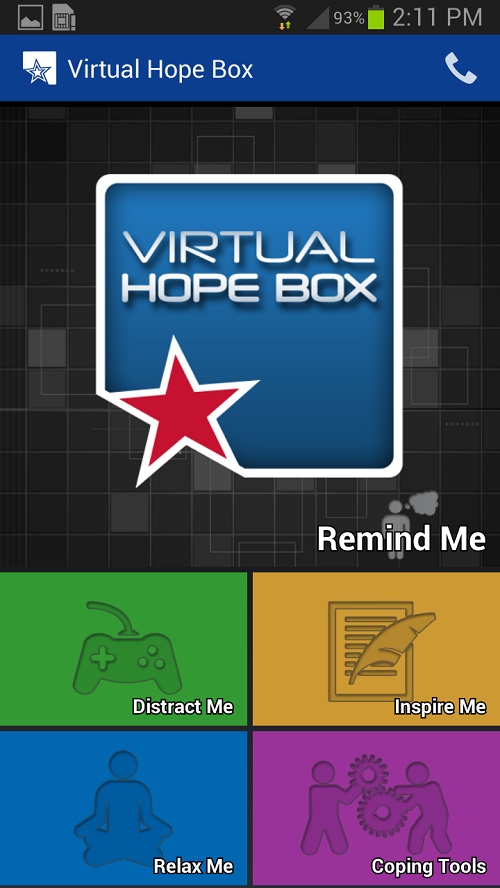Randomized controlled trial study with outpatient Veterans with suicidal ideation comparing the Virtual Hope-Box (VHB) smartphone app vs. comparable printed information. Study found VHB significantly improved coping self-efficacy but no difference in suicidal ideation nor reasons for living. Acceptability and feasibility of VHB shown for Veterans and their clinicians.

One of the key approaches in treating people who are depressed and thinking about suicide is to help them come up with reasons to go on living, and one of the ways that mental health specialists have traditionally done this is to work with their patients to create a “hope box”—a collection of various items that remind the patients that their lives are meaningful and worth living. The items can be anything from photos of loved ones and certificates of past achievements to lists of future aspirations, CDs of relaxing music, and recordings of loved ones offering inspirations thoughts. The hope box itself can take various forms: a real wooden box or shoe box, a manila envelope, a plastic bag, or anything else that the patient chooses. The patient is asked to keep the hope box nearby and use its contents when it seems hard to go on living.
But it is not always easy to keep such a hope box close at hand. A depressed Veteran or service member might find it inconvenient to take the hope box to work, for example, or might forget to bring it along on a trip. For this reason Nigel Bush and his colleagues at the National Center for Telehealth and Technology have designed a “virtual hope box,” a smartphone app that allows the patient to keep all those reasons for living close by at all times.
The virtual hope box has all the same life-affirming reminders that the traditional sort of hope box does—photos, videos, favorite music, messages from loved ones, and so on—but it has much more. It includes, for instance, a list of key contacts—people who have agreed to be available for a phone call in a time of crisis. It has a collection of “coping cards” in which the patient has written down positive alternatives to each of the negative items that tend to cause problems. There are relaxation exercises to help the patient calm down and puzzles to take the patient’s mind off negative thoughts. But the most important thing about the virtual hope box is its accessibility—it can always be there, in a pocket or purse.
Throughout much of 2013 Bush and his colleagues were carrying out usability testing on an initial version of the virtual hope box, a project that was also funded by the Consortium. They recruited 18 clinic patients at a VA in the Pacific Northwest who were deemed by their behavioral health providers to be at high risk of suicidal ideation. They provided them with virtual hope boxes in addition to the usual clinic treatments and then queried them on how well the app worked for them and what they liked and didn’t like about it. Judging from their responses, the app worked extremely well, Bush says. The Veterans used it regularly away from the clinic, liked it, and judged it to be beneficial, and their healthcare providers liked it as well.
View "Development and Evaluation of a Virtual Hope Box for Reducing Suicidal Ideation", presented at the 4th Annual DoD/VA Suicide Prevention Conference ![]() Powerpoint Presentation,
Powerpoint Presentation, ![]() PDF Presentation
PDF Presentation
To find ways to improve the virtual hope box, Bush solicited as much feedback as possible from both the patients and the providers. In response to that feedback he and his colleagues have made a variety of changes to the app—making some parts easier to use, reorganizing it quite a bit, and adding a couple of relaxation tools, such as a guided-imagery meditation tool. They have also written a clinician users guide. Although the original version seemed quite successful, Bush expects the new version to prove to be even better.
The research team has received numerous requests for the app over the past year from behavioral health providers who have heard about it. A full version of the app is now available for iOS and Android
Download now: iOS App Store (iPhone & iPad) or Android App Store
In the meanwhile, Bush and his colleagues have embarked on a second study to test the effectiveness of the virtual hope box in helping individuals cope with stress and negative thoughts. One hundred Veterans who are at high risk of suicidal ideation will be recruited from clinics from a regional VA. Half of them will be provided with treatment as usual, while the other half will be given treatment as usual plus the virtual hope box. After a subject completes his or her course of treatment, Bush and his colleagues will question them about the treatment and will administer a variety of tests designed to measure levels of stress and depression, suicidal thoughts, coping skills, and positive thinking. The hope is that those who were provided with the virtual hope box will have improved more throughout the course of their treatment than those who were not.
